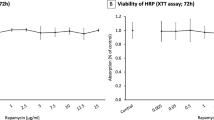Abstract.
Background: Angiostatic drugs might provide desirable modulation of choroidal angiogenesis-related diseases, including histoplasmosis and the exudative form of age-related macular degeneration. However, the precise effects of this class of compounds in the choroidal neovascularization are still unclear. In the present study, we investigated the effects of triamcinolone acetonide (TA), an angiostatic steroid, on choroidal angiogenesis in vitro. Methods: Bovine choroidal endothelial cells (CEC), which are the critical cellular component of choroidal angiogenesis in vivo, were isolated with Lycopersicon esculentum agglutinin-coated Dynabeads and cultured in EGM medium. CEC were treated with basic fibroblast growth factor (bFGF) and TA at various concentrations ranging from 50 to 300 mg/l. The capacities for CEC migration and tube formation were evaluated with the modified Boyden chamber and the Vitrogen collagen assay, respectively. The activities of matrix metalloproteinases (MMP)-2 and -9 were examined using gelatin zymography. Results: The stimulation of CEC with 50 ng/ml bFGF resulted in an increase of about 100% in migration activity (P<0.01). Preincubation of CEC with TA at the indicated concentrations for 20 min inhibited the bFGF-stimulated migration in a dose-dependent manner (P<0.01). After 5 days, the bFGF-stimulated tube formation in CEC was inhibited by TA at the concentrations 100, 150 and 300 mg/l (P<0.01). Gelatin zymography of the culture media of CEC showed that the bFGF-induced activation of MMP-2 was attenuated by 300 mg/l TA (P<0.05). Conclusion: Downregulation of the activation of MMPs in CEC could be one of the mechanisms by which angiostatic steroids inhibit choroidal angiogenesis.
Similar content being viewed by others
Author information
Authors and Affiliations
Additional information
Electronic Publication
Rights and permissions
About this article
Cite this article
Wang, Ys., Friedrichs, U., Eichler, W. et al. Inhibitory effects of triamcinolone acetonide on bFGF-induced migration and tube formation in choroidal microvascular endothelial cells. Graefe's Arch Clin Exp Ophthalmol 240, 42–48 (2002). https://doi.org/10.1007/s00417-001-0398-y
Received:
Revised:
Accepted:
Published:
Issue Date:
DOI: https://doi.org/10.1007/s00417-001-0398-y




